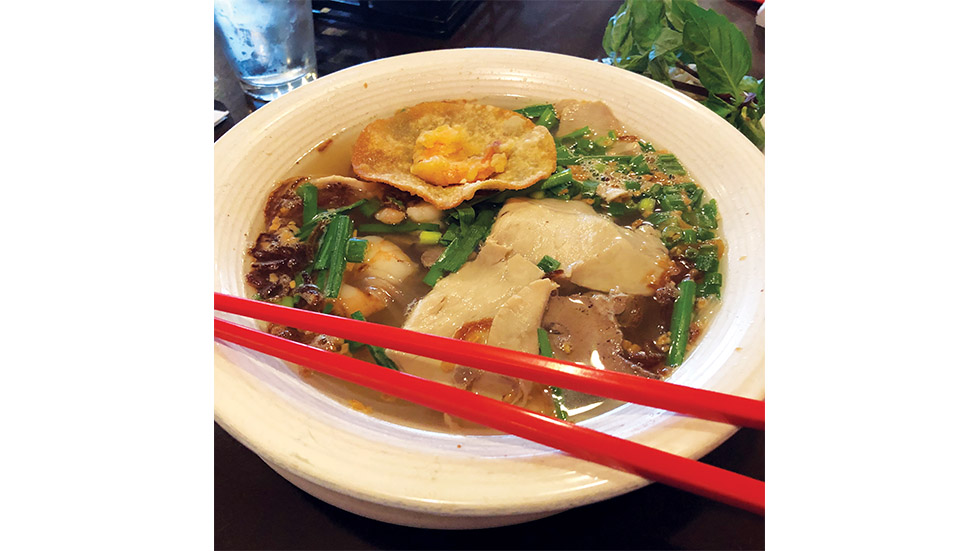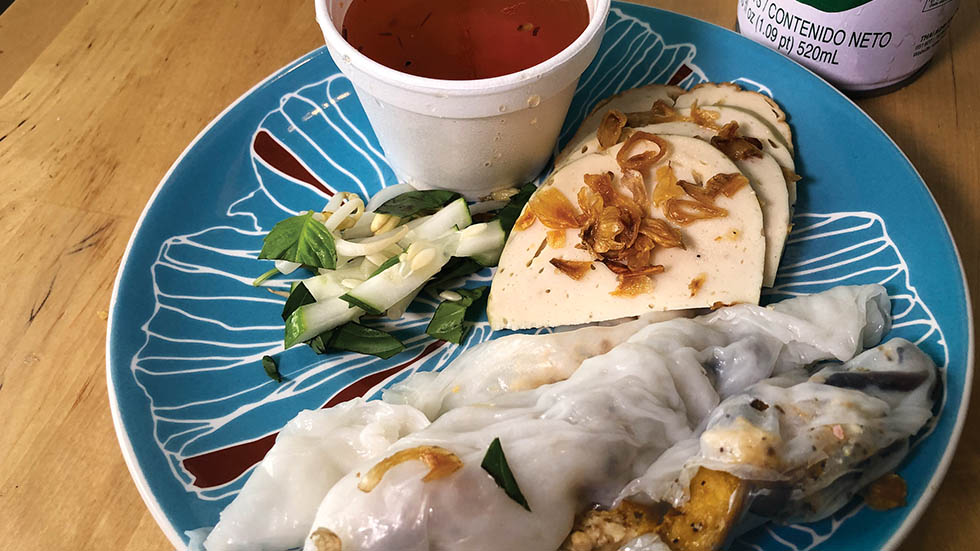Pho and beyond: Oklahoma City’s Asian District

You know you can look forward to having a good bowl of Vietnamese beef noodle soup, or pho, when you can smell its bone-rich broth simmering from outside a restaurant.
That’s certainly the case in Oklahoma City’s Asian District, comprising a half-dozen blocks centered on old Route 66 at North Classen Boulevard and NW 23rd Street a couple miles north of downtown. Here, ornate “Asian District” signs in landscaped medians mark an area with noodle shops, international groceries, tofu shops and boba tea cafes.
In the quarter-century following the end of the Vietnam War in 1975, about one million Vietnamese refugees and immigrants resettled in the US, mostly in California and Texas. But they also settled in Oklahoma, now home to more than 16,000 Vietnamese–Americans.
Most of these residents came to the state with literally a couple of dollars in their pockets and held jobs paying under $2 an hour. But they knew how to cook generations-old recipes, too. Soon, new restaurants appeared in Oklahoma City, serving Vietnamese cuisine’s yin–yang blend of wildly varying ingredients—sour with lemon, hot pepper with sugar. The city’s Vietnamese community helped rescue a once-blighted neighborhood and spark a full-blown foodie scene in the Oklahoma capital.
Now, locals from across the city come for meals under $10 and cafe sua da (Vietnamese ice coffee, served with condensed milk), while restless home chefs chase down ingredients they’ve seen on TV cooking shows at Super Cao Nguyen, a sprawling grocery overlooking a recently added Vietnam War Memorial that features flags of both the US and the former South Vietnam.

Oklahoma City’s Vietnamese offerings stay faithful to traditional recipes, including VII Asian Bistro’s hu tieu nam vang.
NOON IS PHO MAGIC TIME
The most popular Vietnamese dish in the city—like everywhere else—is pho, the beef noodle soup first made in the late 1800s outside Hanoi by combining a Chinese-style rice noodle with the French colonials’ fondness for beef. Pho Lien Hoa is Oklahoma City’s oldest noodle shop, and it still attracts a regular crowd for its steaming bowls of slightly sweet Saigon-style pho.
These days, many locals swear, the best bowl is around the corner. VII Asian Bistro, open since 2013, is a smart-looking noodle shop in an L-shaped shopping strip. Inside, colorful paintings of Vietnamese scenes—brought from Vietnam—look over a couple dozen tables that are often filled around noon.
That’s because noon is the magic time for pho almost anywhere you find it.
“It’s standard procedure to cook it overnight for eight or nine hours,” says David Nguyen, owner of VII Asian Bistro. “But it’s best when you let it simmer two or three more hours before serving.”
Nguyen, a third-generation restaurateur, whose father was the original owner of Pho Lien Hoa (and is now retired), is a big champion of all Oklahoma City’s pho shops.
“The funny thing is that the US serves better pho than in Vietnam,” he says. “They use a lot of preservatives [in Vietnam]. Plus, you get maybe one or two pieces of whole bone in a pot there. In the US, we use 60 to 80 pounds of bone. That’s the difference.”
Noodle shops such as VII Asian Bistro and the nearby Pho Cuong also serve tasty, lesser-known Vietnamese noodle dishes.
One is bun bo hue, a spicy beef soup with slippery round rice noodles, beef and (optional) congealed pork blood—a specialty of Central Vietnam. And there’s hu tieu nam vang, an excellent seafood soup with hu tieu glass noodles, fried garlic, shrimp, pork and a rice cracker. It’s actually a Cambodian-style soup—“nam vang” refers to the Cambodian capital—that has long been a street-food staple in Vietnam’s Ho Chi Minh City (the former Saigon).

Oklahoma City’s Vietnamese offerings stay faithful to traditional recipes, including Pho B&B’s banh xeo Vietnamese pancake
DEEPER DISHES
Over the years, Vietnamese restaurants have gradually migrated into other parts of the metropolis, too. It’s worth venturing to Pho B&B in South Oklahoma City to try banh xeo, Vietnam’s “cake of love.”
Banh xeo is a pancake made of rice flour and turmeric batter fried to crispiness and then topped with grilled shrimp, pork, fried onion and bean sprouts. An order of four comes folded like golden tacos in 15 minutes. It’s a wild mix of flavor, enjoyed by pulling off pieces, wrapping them into fresh leaves of lettuce, and then dipping—bite by bite—into nuoc mam (fish sauce).
Back in the Asian District, another rare dish to search out is banh cuon, a plate of thin, steamed, almost gelatinous rice rolls filled with minced pork, shallots and mushrooms and served cold with nuoc mam. Its texture is a little slimy for first-timers, but its flavors offer the payoff.
It’s not common to find banh cuon outside Vietnam, as the prep takes some art—and time—to get right. My Tran of Nhu Lan Restaurant and Bakery, a family-run eatery with two tables (and popular roast duck or pork take-out orders on weekends), knows this well. “I grew up eating machine-made banh cuon you get at groceries,” Tran explains. “Then I started making it. It’s a whole different world.”

Vietnamese food goes beyond pho, such as banh cuon.
BEHOLD THE BANH MI
Then there’s banh mi, which has emerged as the world’s sandwich de rigeur in recent years. This Vietnamese sandwich uses lightly toasted French bread filled with varying meats—such as smoky thit nuong (grilled pork)—and then lined with an unexpected medley of pickled vegetables, cucumber, cilantro, hot pepper, garlic salt and soy-rich Maggi seasoning sauce. No other sandwich quite compares.
Fresh takeaway banh mi is found at places such as Lee’s Sandwiches, a California-based institution that serves many Vietnamese snacks, or Quoc Bao, a humble donut shop with a cult following for its cheap sandwiches.
Oklahoma City’s best banh mi, though, can be found a couple miles south in Midtown, a revitalized area with food trucks and modernist condos. Here, the stylish Rivière Modern Banh Mi offers a rare sit-down banh mi experience, complete with a full bar serving cocktails, sake and local beers.

Rivière Modern Banh Mi’s James Nguyen creates Korean, German, Cajun and Latin American versions of traditional banh mi sandwiches
Opened in fall 2019, Rivière is run by James Nguyen (no relation to David) and his college friend Sean O’Neill, a veteran of the city’s food scene. Despite the slowdown during quarantine, the restaurant quickly won fans by bending some rules with recipes.
“Banh mi is like a template,” James Nguyen explains. “It’s the homemade garlic aioli, the cucumber, the fresh jalapeños, the cilantro. But why couldn’t you change up the protein? Put in German schnitzel?”
Rivière offers ten banh mi options, ranging from German and traditional grilled pork to Korean-syle bulgogi beef, Cajun-style shrimp and Central American carne asada. The menu is a traditional/nontraditional blend created by James and his mom.
“They argue a lot because they’re both stubborn,” laughs O’Neill. “But when they agree on something, that’s when our best dishes have been made.”
A talent for cooking runs in the Nguyen family. James’ grandfather, Loc Le, who came to the US from Danang, Vietnam, with virtually nothing after the war, now runs Jimmy’s Egg, a popular regional breakfast chain (one location is next door to Rivière).
“Food is always the bridge between people of different cultures,” James notes. “You eat my food; I eat your food. And now I can understand a little more about who you are, where you came from, what you’re like.”
In Oklahoma City, the education is certainly tasty.
